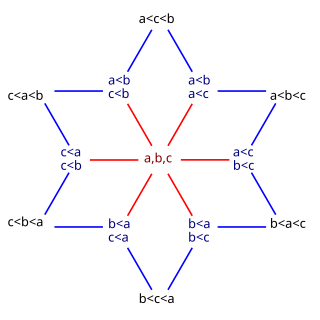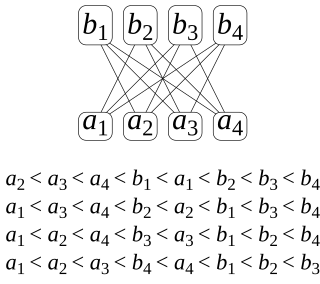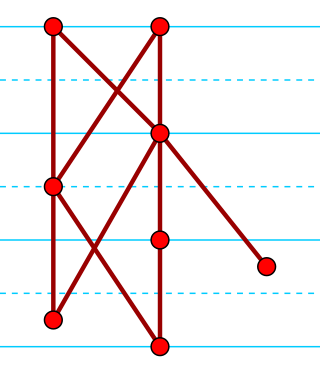In mathematics, a directed set is a nonempty set together with a reflexive and transitive binary relation , with the additional property that every pair of elements has an upper bound. In other words, for any and in there must exist in with and A directed set's preorder is called a direction.

In mathematics, especially order theory, a partially ordered set formalizes and generalizes the intuitive concept of an ordering, sequencing, or arrangement of the elements of a set. A poset consists of a set together with a binary relation indicating that, for certain pairs of elements in the set, one of the elements precedes the other in the ordering. The relation itself is called a "partial order."

In mathematics, especially in order theory, a preorder or quasiorder is a binary relation that is reflexive and transitive. Preorders are more general than equivalence relations and (non-strict) partial orders, both of which are special cases of a preorder: an antisymmetric preorder is a partial order, and a symmetric preorder is an equivalence relation.
In mathematics, a total or linear order is a partial order in which any two elements are comparable. That is, a total order is a binary relation on some set , which satisfies the following for all and in :
- (reflexive).
- If and then (transitive).
- If and then (antisymmetric).
- or .
In mathematics, a complete lattice is a partially ordered set in which all subsets have both a supremum (join) and an infimum (meet). A lattice which satisfies at least one of these properties is known as a conditionally complete lattice. Specifically, every non-empty finite lattice is complete. Complete lattices appear in many applications in mathematics and computer science. Being a special instance of lattices, they are studied both in order theory and universal algebra.
In mathematics, a relation R on a set X is transitive if, for all elements a, b, c in X, whenever R relates a to b and b to c, then R also relates a to c. Each partial order as well as each equivalence relation needs to be transitive.

In mathematics, especially in order theory, a maximal element of a subset S of some preordered set is an element of S that is not smaller than any other element in S. A minimal element of a subset S of some preordered set is defined dually as an element of S that is not greater than any other element in S.
In mathematics, in the area of order theory, an antichain is a subset of a partially ordered set such that any two distinct elements in the subset are incomparable.
Order theory is a branch of mathematics that investigates the intuitive notion of order using binary relations. It provides a formal framework for describing statements such as "this is less than that" or "this precedes that". This article introduces the field and provides basic definitions. A list of order-theoretic terms can be found in the order theory glossary.
This is a glossary of some terms used in various branches of mathematics that are related to the fields of order, lattice, and domain theory. Note that there is a structured list of order topics available as well. Other helpful resources might be the following overview articles:
A lattice is an abstract structure studied in the mathematical subdisciplines of order theory and abstract algebra. It consists of a partially ordered set in which every pair of elements has a unique supremum and a unique infimum. An example is given by the power set of a set, partially ordered by inclusion, for which the supremum is the union and the infimum is the intersection. Another example is given by the natural numbers, partially ordered by divisibility, for which the supremum is the least common multiple and the infimum is the greatest common divisor.

In mathematics, especially in order theory, the greatest element of a subset of a partially ordered set (poset) is an element of that is greater than every other element of . The term least element is defined dually, that is, it is an element of that is smaller than every other element of
In mathematics, a join-semilattice is a partially ordered set that has a join for any nonempty finite subset. Dually, a meet-semilattice is a partially ordered set which has a meet for any nonempty finite subset. Every join-semilattice is a meet-semilattice in the inverse order and vice versa.

In mathematics, especially order theory, a weak ordering is a mathematical formalization of the intuitive notion of a ranking of a set, some of whose members may be tied with each other. Weak orders are a generalization of totally ordered sets and are in turn generalized by partially ordered sets and preorders.

In mathematics, given two preordered sets and the product order is a partial ordering on the Cartesian product Given two pairs and in declare that if and only if and

In mathematics, the dimension of a partially ordered set (poset) is the smallest number of total orders the intersection of which gives rise to the partial order. This concept is also sometimes called the order dimension or the Dushnik–Miller dimension of the partial order. Dushnik & Miller (1941) first studied order dimension; for a more detailed treatment of this subject than provided here, see Trotter (1992).
In mathematics, a homogeneous relation over a set X is a binary relation over X and itself, i.e. it is a subset of the Cartesian product X × X. This is commonly phrased as "a relation on X" or "a (binary) relation over X". An example of a homogeneous relation is the relation of kinship, where the relation is over people.
In mathematics, Birkhoff's representation theorem for distributive lattices states that the elements of any finite distributive lattice can be represented as finite sets, in such a way that the lattice operations correspond to unions and intersections of sets. The theorem can be interpreted as providing a one-to-one correspondence between distributive lattices and partial orders, between quasi-ordinal knowledge spaces and preorders, or between finite topological spaces and preorders. It is named after Garrett Birkhoff, who published a proof of it in 1937.
In order theory, the Szpilrajn extension theorem, proved by Edward Szpilrajn in 1930, states that every strict partial order is contained in a total order. Intuitively, the theorem says that any method of comparing elements that leaves some pairs incomparable can be extended in such a way that every pair becomes comparable. The theorem is one of many examples of the use of the axiom of choice in the form of Zorn's lemma to find a maximal set with certain properties.

In order theory, a branch of mathematics, a semiorder is a type of ordering for items with numerical scores, where items with widely differing scores are compared by their scores and where scores within a given margin of error are deemed incomparable. Semiorders were introduced and applied in mathematical psychology by Duncan Luce (1956) as a model of human preference. They generalize strict weak orderings, in which items with equal scores may be tied but there is no margin of error. They are a special case of partial orders and of interval orders, and can be characterized among the partial orders by additional axioms, or by two forbidden four-item suborders.